
Keke Kaikhosroshvili
Keke is Zavvy's expert in learning experience. On our blog, she shares experience and insights based on her studies in learning design and experiences made with our customers.

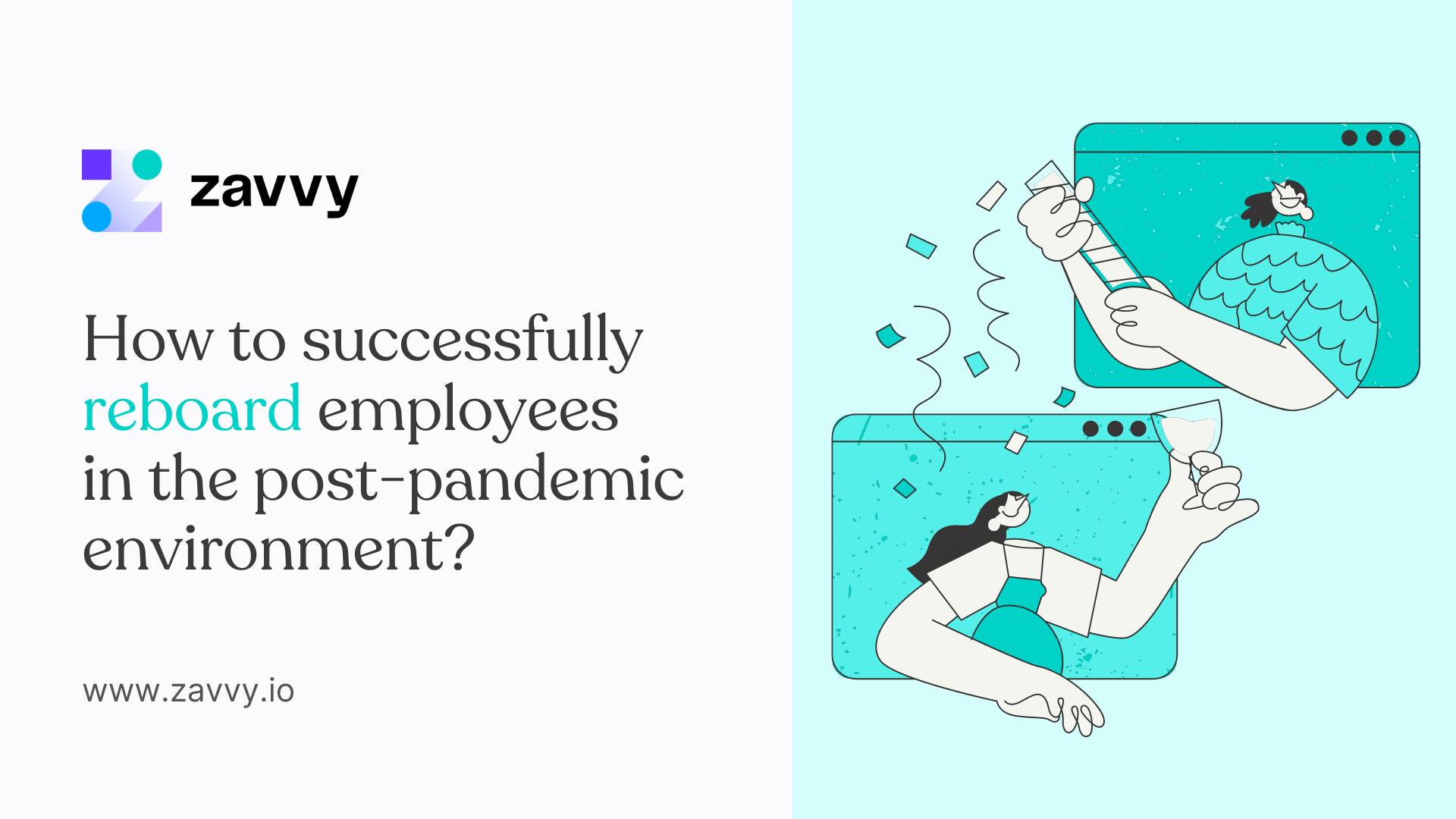
Traditionally, reboarding was mostly about introducing employees to the workplace after returning from breaks like parental leaves, sabbaticals, or in the case of promotions.
However, the pandemic has added a new meaning to it:
As the restrictions get lifted, organizations either continue to work remotely or request employees to return to the office. Any way, employees need continuous support through the transition process.
And that is done with an effective reboarding plan.
This article will extensively cover the reboarding process–from establishing a reboarding system to its implementation.
Together with our curators, we have created a library of actionable digital marketing resources. Personalized to your team's needs.
Reboarding is the process of familiarizing existing employees with your organization, its policies, and their roles after being away for a while - or after massive change. Re-onboarded employees are more aware of your organization's structure, culture, and administrative processes.
The reboarding process is determined based on the industry and organization at hand. However, reboarding comprises three consistent elements:
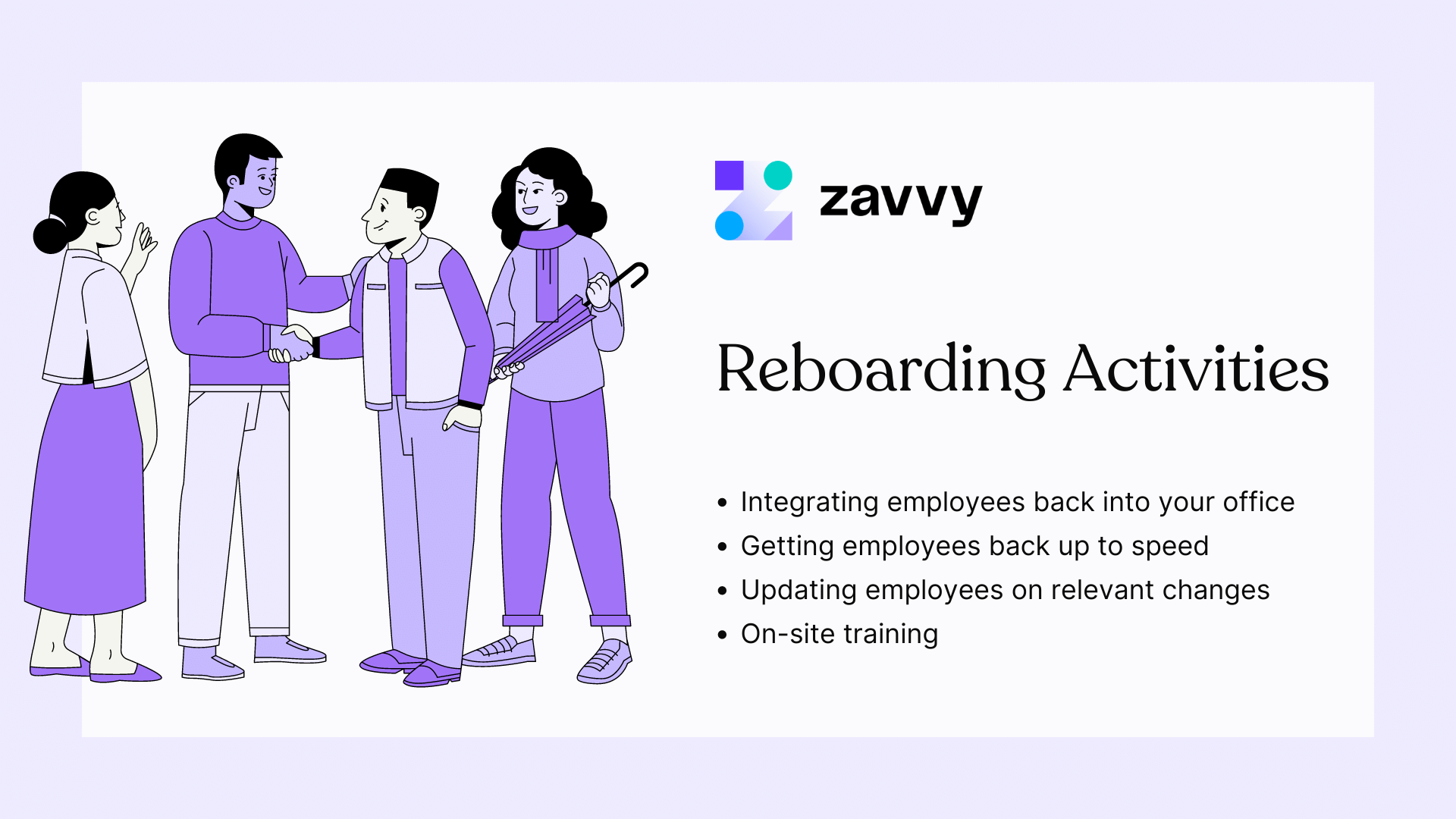
Think of reboarding as targeted employee onboarding. While reboarding is mainly for existing employees, onboarding is the first step to introducing new employees to your organization. It is implemented to ensure employees are guided through your company's policy, compliance, workplace culture and establish connections between new and existing employees.
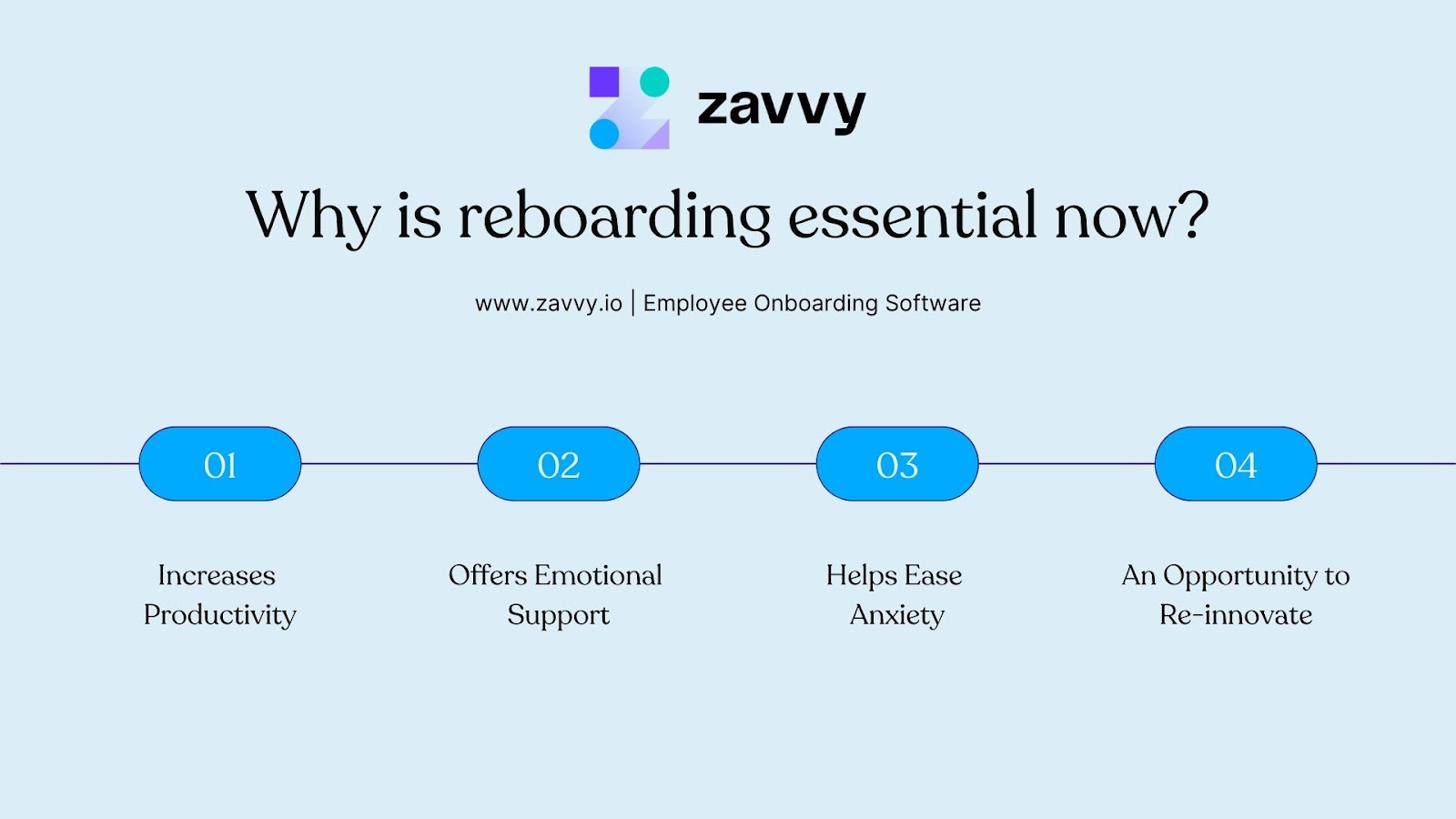
The pandemic has altered the employment landscape and redefined how employees work and interact with their job and colleagues. The changes orchestrated by the health crisis required organizations to redesign a new employee experience based on the 'new normal.'
As HR manager, it's you job to implement business continuity plans, modify internal processes and procedures, and ensure a smooth transition to remote/hybrid working. This includes reboarding your employees in the best way possible. The top reasons to re-onboard your employees are:
Updating your employees immediately after their return enables them to settle quickly and return to work. In addition, offering clarity about their position and expectations helps them focus and deliver on the tasks ahead of them.
Reboarding encourages employees to feel engaged, welcomed, and reconnected to your organization. As we shift back to work from the office, employees might feel uncomfortable reconnecting with their colleagues after a long period. A reboarding process offers much-needed emotional support to your new and existing employees.
Returning employees will have several questions or concerns like
A structured reboarding plan clarifies small details and eliminates any stress from employees.
Through reboarding, your employees can refocus on work that matters. In return, this attribute fosters positivity and productivity as employees become accustomed to the latest version of normal.
As many companies are reimagining their work models, a company-wide reboarding process is their chance to communicate and establish their new hybrid work policies or flexible work models.
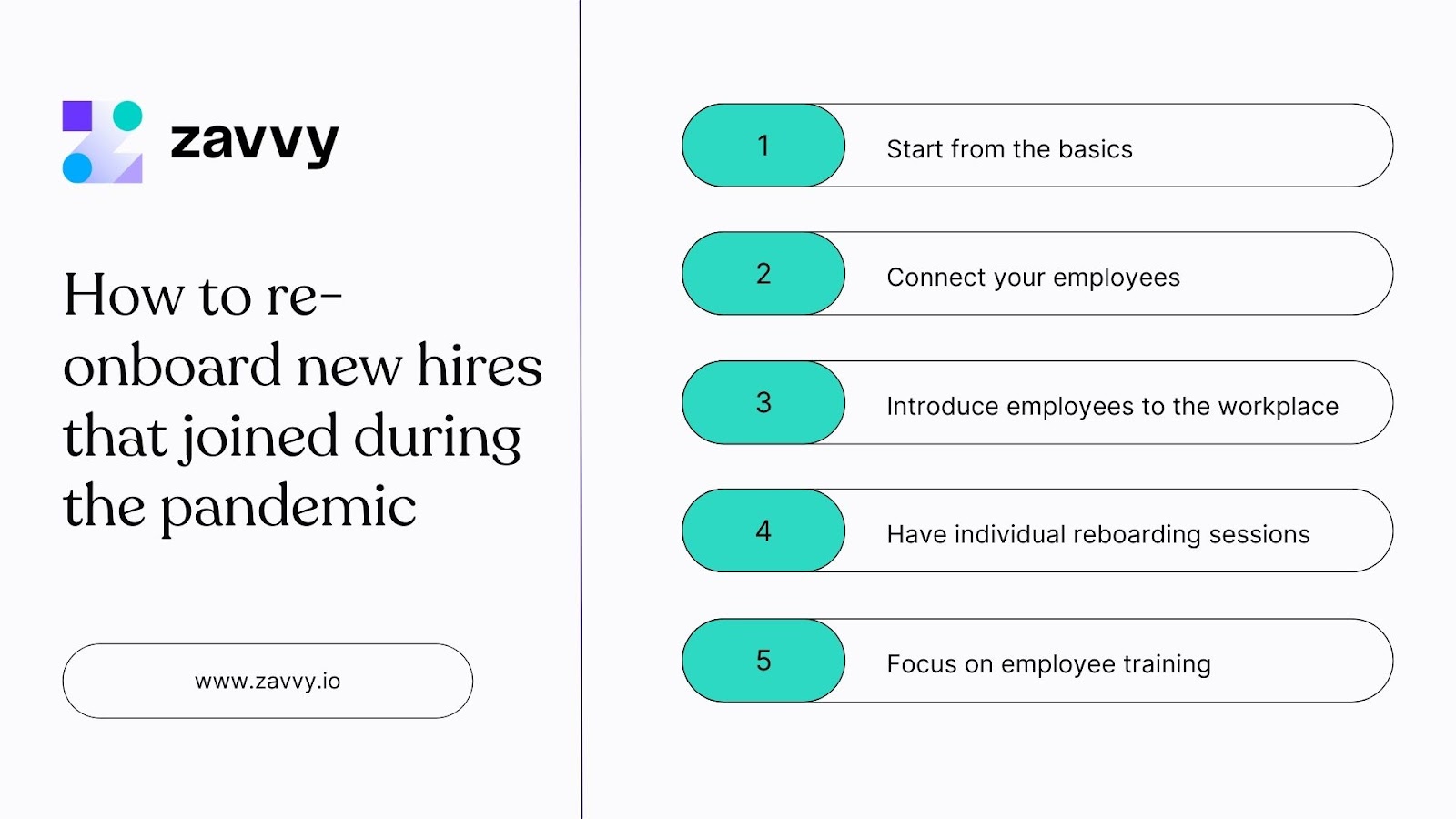
Many people have started a new job during the pandemic - and have never met their teammates in person. In fact, the shift to remote was quite turbulent for many companies - and onboarding procedures suffered.
With your company returning to more stable ways of working, it's your chance to give your colleagues that experience back.
This is powerful for two reasons:
First, it integrates them into your system and builds community. And second, reboarding new hires helps to align your organizational goals with theirs.
Chances are this is the step that people missed out on the most.
Cohorts of people starting at the same time are usually connected by a strong bond. They are all equally insecure, equally starting a new life. Joint onboarding can create friendships for years to come. This obviously has a strong impact on the overall candidate experience.
So: Find ways to informally connect people with each other.
Pair them up with employees from different departments and backgrounds.
As you re-onboard new hires, they will have questions on their roles and responsibilities, medical benefits concerns, and time policies. Therefore, consider regular communication and updating policies.
Your remote new hires might never have been to your office. If this is the case, show them around! Give them a tour of need-to-know places, lunch locations, and simply take a walk. Depending on local regulations and industry, you might also need to give them a safety-at-work training.
A face-to-face reboarding chat can be more effective between the manager and employee. A manager can determine how well the new hire is settling into their role. The manager can also offer alternative means to help the new hire settle when necessary. Facilitate that conversation by giving both parties a few guidelines to consider.
Focus on topics that will assist new employees in completing tasks productively. They need a clear learning path and comprehensive checklists to ensure they work efficiently. Managers can also conduct practical assessments to ensure employees perform based on the set expectations while away.
Re-boarding in a post-pandemic environment goes beyond bringing employees up to speed with the latest development in your organization. Instead, the approach deployed by the organization should establish your work policy and safeguard your employees' health.
During the post-pandemic, reboarding can apply to:
In general, the Covid-19 pandemic has changed how organizations work and find effective ways to welcome back employees. Therefore, reboarding employees is not an easy task. Whether you're working remotely or have embraced a hybrid work model, it is crucial to communicate your updated policies, ways of communication, office structure (for new hires), and redefined roles.
1. Physical workplace: As an employer, you should ensure the facility is safe and minimize any risk of infection if you plan to resume physical work. Before reboarding, provide sufficient space for social distancing and adequate sanitation facilities.
For safety, consider factors like:
2. Mental health: The onset of the pandemic has had a mental toll on most individuals due to isolation. An organization reboarding should focus on having a mental health first aid mechanism. Show support to your employees by initiating wellness activities like therapy, meditation, fitness classes, and more.
3. Communication strategy: An organization should have an open communication channel and offer necessary feedback when needed. The communication system should clearly articulate new policies or changes in the existing ones. Additionally, employees should feel free to air their views.
In general, reboarding manually can be challenging for most organizations due to the tedious work involved. Zavvy offers several onboarding solutions that focus on set goals, eliminating manual work.
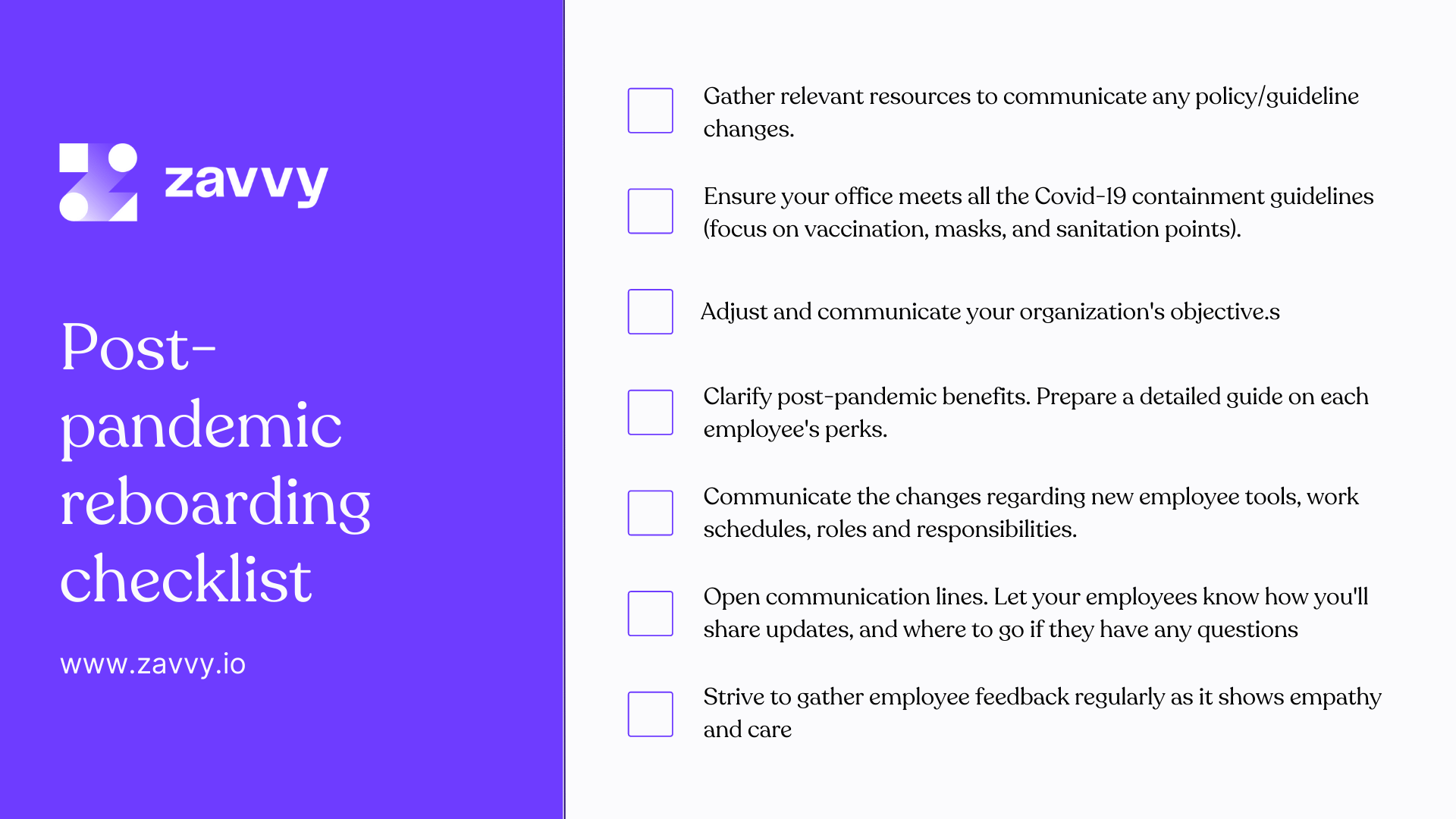
An organization's post-pandemic reboarding checklist is guided by two factors: before returning to work and when you resume work. The checklist should match the following aspects:
This one is mainly for people returning from maternity/paternity leave, sabbaticals, longer sick leaves, etc.
Once you've been out for more than a couple of months, chances are you've missed quite a few things.
Here's what to take into account:
Prepare relevant material and resources. Your employees might have various questions about the organization's path and your expectations. Therefore, you can prepare valuable materials, including reboarding FAQ documents alongside opening communication channels to answer any questions they might have.
Communicate what's changed. Try to convey essential information to the employees on the potential impact of their absence on the organization. Communicate any changes that occurred during the break period, including new hires, departures, organizational structure changes, cost savings, and more. Notably, communication will reassure employees that they are valued, contributing to their overall productivity.
Send a pre-reboarding email. Send an email to the returning employees before they report. The email should have all the details to ensure they have everything they need to get started.
Be aware: Having been gone for a while and noticing that things have also somehow worked out without you, can cause insecurity. Make sure to emphasize your re-joiners prior contributions. Show them you care. Show them your team is glad that they're back.
Re-boarding is not a one-time activity. Organizations should understand reboarding is a slow process that needs careful planning and implementation. Re-boarding is emerging as a critical part of the employee journey, although most organizations often overlook it.
If you are keen on what a reboarding solution can impact your organization, you can focus on third-party solutions. Zavvy is the easiest way to foster performance, culture, and well-being. Whether your team is remote, hybrid, or in-office, you can handle the onboarding and reboarding or create a unique hybrid work environment through our solutions.
Upskill your team every week with the best contents and personalized recommendations.

Traditionally, reboarding was mostly about introducing employees to the workplace after returning from breaks like parental leaves, sabbaticals, or in the case of promotions.
However, the pandemic has added a new meaning to it:
As the restrictions get lifted, organizations either continue to work remotely or request employees to return to the office. Any way, employees need continuous support through the transition process.
And that is done with an effective reboarding plan.
This article will extensively cover the reboarding process–from establishing a reboarding system to its implementation.
Get a demo!
We'll be happy to show you around and answer all your questions.
Trusted by innovative companies



We'll be happy to show you around, answer your questions, or arrange a free trial.
Erhalten Sie eine kostenlose Demo unserer Onboarding-Software.
Vertraut von



Your Training & Development Strategy - Solved in 1 Tool.
Trusted by innovative companies



We'll be happy to show you around, answer your questions, or arrange a free trial.
Learn how Zavvy helps you drive performance, development, and engagement.
Trusted by innovative companies



We'll be happy to show you around, answer your questions, or arrange a free trial.
We'll be happy to show you around and answer all your questions.
Trusted by innovative companies



We'll be happy to show you around, answer your questions, or arrange a free trial.
Gerne zeigen wir Ihnen ganz unverbindlich unsere Plattform im Detail.
Vertraut von modernen Unternehmen



Get a demo!
We'll be happy to show you around and answer all your questions.
Trusted by innovative companies



We'll be happy to show you around, answer your questions, or arrange a free trial.
Erhalten Sie eine kostenlose Demo unserer Software für Mitarbeiterenwicklung und Training.
Moderne Unternehmen
setzen auf Zavvy


